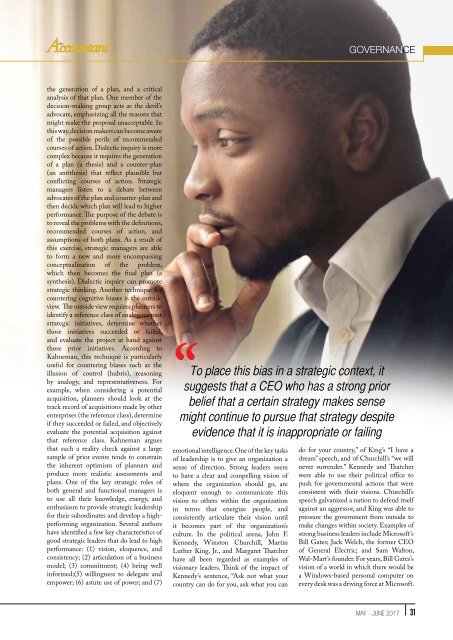The Accountant-May-June 2017
Create successful ePaper yourself
Turn your PDF publications into a flip-book with our unique Google optimized e-Paper software.
governance<br />
the generation of a plan, and a critical<br />
analysis of that plan. One member of the<br />
decision-making group acts as the devil’s<br />
advocate, emphasizing all the reasons that<br />
might make the proposal unacceptable. In<br />
this way, decision makers can become aware<br />
of the possible perils of recommended<br />
courses of action. Dialectic inquiry is more<br />
complex because it requires the generation<br />
of a plan (a thesis) and a counter-plan<br />
(an antithesis) that reflect plausible but<br />
conflicting courses of action. Strategic<br />
managers listen to a debate between<br />
advocates of the plan and counter-plan and<br />
then decide which plan will lead to higher<br />
performance. <strong>The</strong> purpose of the debate is<br />
to reveal the problems with the definitions,<br />
recommended courses of action, and<br />
assumptions of both plans. As a result of<br />
this exercise, strategic managers are able<br />
to form a new and more encompassing<br />
conceptualization of the problem,<br />
which then becomes the final plan (a<br />
synthesis). Dialectic inquiry can promote<br />
strategic thinking. Another technique for<br />
countering cognitive biases is the outside<br />
view. <strong>The</strong> outside view requires planners to<br />
identify a reference class of analogous past<br />
strategic initiatives, determine whether<br />
those initiatives succeeded or failed,<br />
and evaluate the project at hand against<br />
those prior initiatives. According to<br />
Kahneman, this technique is particularly<br />
useful for countering biases such as the<br />
illusion of control (hubris), reasoning<br />
by analogy, and representativeness. For<br />
example, when considering a potential<br />
acquisition, planners should look at the<br />
track record of acquisitions made by other<br />
enterprises (the reference class), determine<br />
if they succeeded or failed, and objectively<br />
evaluate the potential acquisition against<br />
that reference class. Kahneman argues<br />
that such a reality check against a large<br />
sample of prior events tends to constrain<br />
the inherent optimism of planners and<br />
produce more realistic assessments and<br />
plans. One of the key strategic roles of<br />
both general and functional managers is<br />
to use all their knowledge, energy, and<br />
enthusiasm to provide strategic leadership<br />
for their subordinates and develop a highperforming<br />
organization. Several authors<br />
have identified a few key characteristics of<br />
good strategic leaders that do lead to high<br />
performance: (1) vision, eloquence, and<br />
consistency; (2) articulation of a business<br />
model; (3) commitment; (4) being well<br />
informed;(5) willingness to delegate and<br />
empower; (6) astute use of power; and (7)<br />
To place this bias in a strategic context, it<br />
suggests that a CEO who has a strong prior<br />
belief that a certain strategy makes sense<br />
might continue to pursue that strategy despite<br />
evidence that it is inappropriate or failing<br />
emotional intelligence. One of the key tasks<br />
of leadership is to give an organization a<br />
sense of direction. Strong leaders seem<br />
to have a clear and compelling vision of<br />
where the organization should go, are<br />
eloquent enough to communicate this<br />
vision to others within the organization<br />
in terms that energize people, and<br />
consistently articulate their vision until<br />
it becomes part of the organization’s<br />
culture. In the political arena, John F.<br />
Kennedy, Winston Churchill, Martin<br />
Luther King, Jr., and Margaret Thatcher<br />
have all been regarded as examples of<br />
visionary leaders. Think of the impact of<br />
Kennedy’s sentence, “Ask not what your<br />
country can do for you, ask what you can<br />
do for your country,” of King’s “I have a<br />
dream” speech, and of Churchill’s “we will<br />
never surrender.” Kennedy and Thatcher<br />
were able to use their political office to<br />
push for governmental actions that were<br />
consistent with their visions. Churchill’s<br />
speech galvanized a nation to defend itself<br />
against an aggressor, and King was able to<br />
pressure the government from outside to<br />
make changes within society. Examples of<br />
strong business leaders include Microsoft’s<br />
Bill Gates; Jack Welch, the former CEO<br />
of General Electric; and Sam Walton,<br />
Wal-Mart’s founder. For years, Bill Gates’s<br />
vision of a world in which there would be<br />
a Windows-based personal computer on<br />
every desk was a driving force at Microsoft.<br />
MAY - JUNE <strong>2017</strong> 31

















